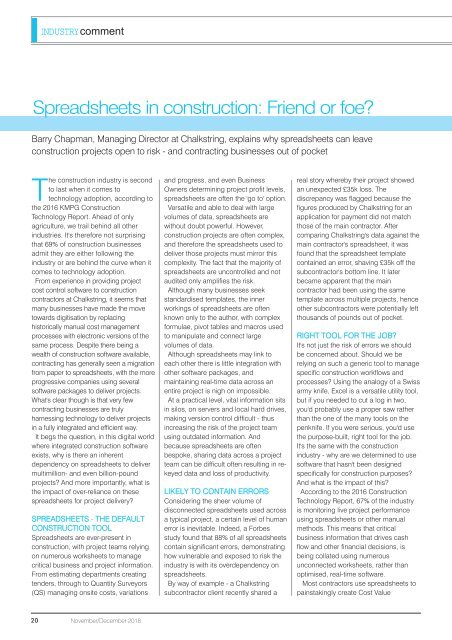CU1811
You also want an ePaper? Increase the reach of your titles
YUMPU automatically turns print PDFs into web optimized ePapers that Google loves.
INDUSTRY comment<br />
Spreadsheets in construction: Friend or foe?<br />
Barry Chapman, Managing Director at Chalkstring, explains why spreadsheets can leave<br />
construction projects open to risk - and contracting businesses out of pocket<br />
The construction industry is second<br />
to last when it comes to<br />
technology adoption, according to<br />
the 2016 KMPG Construction<br />
Technology Report. Ahead of only<br />
agriculture, we trail behind all other<br />
industries. It's therefore not surprising<br />
that 69% of construction businesses<br />
admit they are either following the<br />
industry or are behind the curve when it<br />
comes to technology adoption.<br />
From experience in providing project<br />
cost control software to construction<br />
contractors at Chalkstring, it seems that<br />
many businesses have made the move<br />
towards digitisation by replacing<br />
historically manual cost management<br />
processes with electronic versions of the<br />
same process. Despite there being a<br />
wealth of construction software available,<br />
contracting has generally seen a migration<br />
from paper to spreadsheets, with the more<br />
progressive companies using several<br />
software packages to deliver projects.<br />
What's clear though is that very few<br />
contracting businesses are truly<br />
harnessing technology to deliver projects<br />
in a fully integrated and efficient way.<br />
It begs the question, in this digital world<br />
where integrated construction software<br />
exists, why is there an inherent<br />
dependency on spreadsheets to deliver<br />
multimillion- and even billion-pound<br />
projects? And more importantly, what is<br />
the impact of over-reliance on these<br />
spreadsheets for project delivery?<br />
SPREADSHEETS - THE DEFAULT<br />
CONSTRUCTION TOOL<br />
Spreadsheets are ever-present in<br />
construction, with project teams relying<br />
on numerous worksheets to manage<br />
critical business and project information.<br />
From estimating departments creating<br />
tenders, through to Quantity Surveyors<br />
(QS) managing onsite costs, variations<br />
and progress, and even Business<br />
Owners determining project profit levels,<br />
spreadsheets are often the 'go to' option.<br />
Versatile and able to deal with large<br />
volumes of data, spreadsheets are<br />
without doubt powerful. However,<br />
construction projects are often complex,<br />
and therefore the spreadsheets used to<br />
deliver those projects must mirror this<br />
complexity. The fact that the majority of<br />
spreadsheets are uncontrolled and not<br />
audited only amplifies the risk.<br />
Although many businesses seek<br />
standardised templates, the inner<br />
workings of spreadsheets are often<br />
known only to the author, with complex<br />
formulae, pivot tables and macros used<br />
to manipulate and connect large<br />
volumes of data.<br />
Although spreadsheets may link to<br />
each other there is little integration with<br />
other software packages, and<br />
maintaining real-time data across an<br />
entire project is nigh on impossible.<br />
At a practical level, vital information sits<br />
in silos, on servers and local hard drives,<br />
making version control difficult - thus<br />
increasing the risk of the project team<br />
using outdated information. And<br />
because spreadsheets are often<br />
bespoke, sharing data across a project<br />
team can be difficult often resulting in rekeyed<br />
data and loss of productivity.<br />
LIKELY TO CONTAIN ERRORS<br />
Considering the sheer volume of<br />
disconnected spreadsheets used across<br />
a typical project, a certain level of human<br />
error is inevitable. Indeed, a Forbes<br />
study found that 88% of all spreadsheets<br />
contain significant errors, demonstrating<br />
how vulnerable and exposed to risk the<br />
industry is with its overdependency on<br />
spreadsheets.<br />
By way of example - a Chalkstring<br />
subcontractor client recently shared a<br />
real story whereby their project showed<br />
an unexpected £35k loss. The<br />
discrepancy was flagged because the<br />
figures produced by Chalkstring for an<br />
application for payment did not match<br />
those of the main contractor. After<br />
comparing Chalkstring's data against the<br />
main contractor's spreadsheet, it was<br />
found that the spreadsheet template<br />
contained an error, shaving £35k off the<br />
subcontractor's bottom line. It later<br />
became apparent that the main<br />
contractor had been using the same<br />
template across multiple projects, hence<br />
other subcontractors were potentially left<br />
thousands of pounds out of pocket.<br />
RIGHT TOOL FOR THE JOB?<br />
It's not just the risk of errors we should<br />
be concerned about. Should we be<br />
relying on such a generic tool to manage<br />
specific construction workflows and<br />
processes? Using the analogy of a Swiss<br />
army knife, Excel is a versatile utility tool,<br />
but if you needed to cut a log in two,<br />
you'd probably use a proper saw rather<br />
than the one of the many tools on the<br />
penknife. If you were serious, you'd use<br />
the purpose-built, right tool for the job.<br />
It's the same with the construction<br />
industry - why are we determined to use<br />
software that hasn't been designed<br />
specifically for construction purposes?<br />
And what is the impact of this?<br />
According to the 2016 Construction<br />
Technology Report, 67% of the industry<br />
is monitoring live project performance<br />
using spreadsheets or other manual<br />
methods. This means that critical<br />
business information that drives cash<br />
flow and other financial decisions, is<br />
being collated using numerous<br />
unconnected worksheets, rather than<br />
optimised, real-time software.<br />
Most contractors use spreadsheets to<br />
painstakingly create Cost Value<br />
20<br />
November/December 2018

















